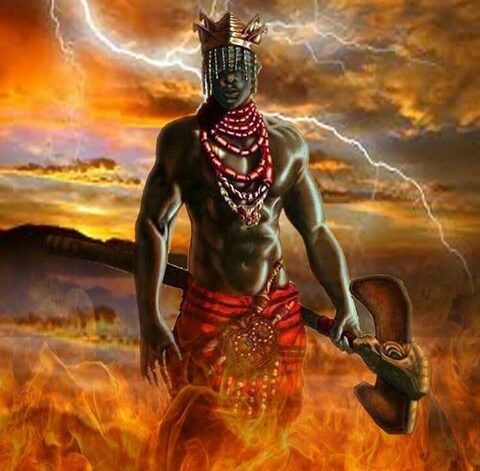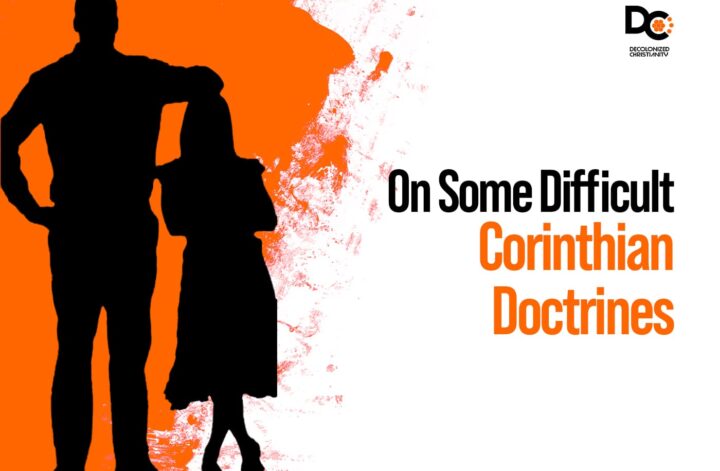Background
Sàngó’s story belongs to the very beginning of the Yorùbá nation which is believed to be founded by Odùduwà after migrating from “the East” to Ilé-Ifè. According to Samuel Johnson, Odùduwà might have originated from somewhere near modern-day Sudan or Egypt (5). People lived in the land before Odùduwà and his entourage got there (Johnson, 18); indeed, Odùduwà met Setilu, the father of Ifá worship, in the land (4). As is true of all empires, not all the people in the Ọ̀yọ́ empire were originally natives. Many of the different tribes that self-identify as Yoruba today likely had ancestors who identified differently. As Odùduwà and his army advanced, they absorbed natives of the land into the dominant culture of proto-Yorùbá. As I shall show later, the narrative fed to the people of an empire can be a powerful political tool having the effect of conferring a common identity and solidarity to a people group.
According to one version of the account, Odùduwà’s eldest son, Ọ̀kànbí, gave birth to seven princesses and princes, the youngest of whom was Ọ̀rányàn (also known as Ọ̀rànmíyàn) who was the progenitor of ancient Ọ̀yọ́ Yorùbá people. Ọ̀rànmíyàn proved to be most skillful and wealthiest among his siblings, so much so he was confirmed as the king or Aláàfin at Ilé-Ifẹ̀ following the death of his grandfather. The siblings ruled in distant provinces from Ifẹ̀. Having established his government, Ọ̀rányàn moved the seat of government to Old Oyo also called Ọ̀yọ́ Àjàká, a place about 100 miles north of modern-day Oyo (Morton-Williams, 247), leaving a trusted slave in charge at Ife. Ọ̀rányàn had two sons of relevance to us: Àjùàn, better known as Àjàká, and the younger Olúfiran who is better known as Sàngó. (Yoruba naming practices highly valued nicknames. Nicknames functioned as effectively as birth names. Even “Oranmiyan” is a cognomen.) Aláàfin Àjàká was the only Yoruba king to be enthroned twice (Johnson, 176). His first reign was cut short, allowing Sàngó to be crowned. Following Sàngó’s death, Ọba Àjàká was enthroned a second time.
Sàngó—the restless and tyrannical human ruler
There are several divergent accounts on the person of Sàngó, ranging from mythical to historical. According to one account, Ọ̀rányàn’s military expeditions took him as far as Nupe, the land of Tapa people. (The Ọ̀yọ́ empire would later annex some parts of Nupe which now are in modern-day Kwara and Niger states of Nigeria.) The Nupe king of the time, Elempe, gave Torosi, her daughter, in a diplomatic marriage to Ọ̀rányàn. This marriage produced Sàngó. She died while Sàngó was a baby (Johnson, 177). In time, Sàngó began to experiment with emitting fire from his mouth and attracting lightning – a feat for which he would be universally known.
One account of how Sàngó became the Aláàfin goes thus. Many years after Ọ̀rànmíyàn settled at Ọ̀yọ́ Àjàká, he visited Ilé-Ifẹ̀, leaving his oldest son Ajuan in charge as a regent. Unlike Ọ̀rànmíyàn, however, Ajuan “was of a peaceful disposition” (Johnson, 176). Ọ̀rànmíyàn took an unexpectedly long time to return, and the roads became increasingly dangerous to travel. Provincial kings, especially the Olówu of Òwu, threatened the sovereignty of this Ọ̀yọ́ kingdom, knowing that there was a leadership vacancy of some sorts. This led to Ajuan’s confirmation as the Aláàfin. But the threats to the kingdom only worsened. The Olówu, an uncle to Aláàfin Àjàká, even compelled the Aláàfin to pay tributes to him. The Aláàfin seemed to have obliged. This likely was the reason for the dethronement of the King (Johnson,176). (This was before it became a thing in Yoruba land for an Ọba to commit suicide following his rejection.) The people then confirmed Sàngó as the new Aláàfin. Thus, Sàngó is the third Aláàfin at Old Ọ̀yọ́ but the fourth since the kingdom was established at Ifẹ̀.
Sàngó was more like his warring father and was restless – this is probably why the people deemed him more suitable than his brother. His entire reign lasted only seven years, but long enough to defeat the Olówu in battle. After repeatedly refusing to pay homage to the Olówu, a battle broke out. Johnson explains, “Sango there displayed his wonted bravery as well as his tricks; volumes of smoke issuing from his mouth and nostrils so terrified the Olowu and his army that they became panic stricken and were completely routed and put to fight” (176). Sàngó bravely defended his kingdom and became secure on the throne. However, he also became tyrannical over time, slowly incurring the displeasure of the people.
Sàngó “was said to have the knowledge of some preparation by which he could attract lightning,” continues Johnson (177). On one occasion, Sàngó’s experimentation with lightning went wrong as he miscalculated his coordinates and lit up his palace in flames. This mishap killed many of his family members in the palace. According to one version of the story, Sàngó became disheartened and wanted to leave for his maternal grandfather’s kingdom in Nupe. But a more likely account claims that the people rejected him. Forsaken by loved ones including a favourite wife, Ọya, Sàngó “resolved to end his own life; and climbing on a shea butter tree, he hanged himself (Johnson, 179) at a place called Kòso. This may have influenced the later practice of regal suicide following popular rejection. King Àjàká was enthroned a second time.
Yoruba Cosmos—a brief commentary
Yoruba cosmos is a three-part structure: ọ̀run (mystical sky or heaven), ilé aiyé (the habitable middle part), and ilẹ̀ (the Earth, which may be a composite of ilé aiyé and the oceans.) Like many ancients, Yorùbá ancestors reasoned that spirit beings were behind natural forces and entities. This does not mean that the ancestors were ignorant of natural forces. Instead, they sought spirit beings to help maintain the order they were all too well aware was necessary for productive living. Thus, there is a plethora of divine beings in Yorùbá worldview but still arguably monotheistic.
The supreme being, Olódùmarè or Ọlọ́run (literally, owner of sky or heaven), inhabits the top tier of the cosmos. Importantly, as Morton-Williams observes, Olódùmarè does not have a cult among humans, though people would often seek his help in desperate situations (246).
Sàngó—the god of thunder
The deification of Sàngó began shortly after his death when some of his loyalists tried to stop the derogatory rumor that the king committed suicide. One popular account asserts that the loyalists travelled to Ibariba, west of old Ọ̀yọ́ (whose people are in modern-day Republic of Benin and west-central Nigeria), for a gunpowder-imbued formula capable of attracting lightning. On their return, the loyalists would plant the gunpowder charm in the houses of the people they wanted to punish so that lightning would strike down their buildings. Naturally, this would have communicated to the people that Ọba kò so. That is, the king did not commit suicide; he lives to punish offenders. (See Schiltz, 73.) And thus, Sàngó became a god of thunder. A curious development would follow the apotheosis.
The Aláàfin as personified Sàngó
By a deliberate political calculation, a seating Alaafin of Ọ̀yọ́ later became deemed a Sàngó representative. Morton-Williams writes that the Sango cult became “linked closely through beliefs about Sango as a deified Alafin and, through its organization, with the powers of the king of Ọyọ, who was himself, both as a descendant of Sango and also as king, the vessel for some of Sango’s power.” (255) The Aláàfin became personally, as opposed to mediating through his chiefs, invested in leading the affairs of the Sàngó cult. Though he served all òrìṣà, the Aláàfin became a Sàngó incarnate (Morton-Williams, 257). Marc Schiltz writes, “As Oyo’s power expanded in Yorubaland and among various non-Yoruba speaking peoples in the 17th and 18th centuries, the Alaafin’s control over the Sango cult became an instrument for asserting his sovereignty all over the empire.” (67) This move is politically brilliant for two reasons.
First, Yorubaland is said to have one of the highest frequencies of lightning in the world (Schiltz, 69). Though there are other natural forces like the sun and stars that visited the land with more regularity, few were more destructive than lightning. None conveys the power of the king as efficaciously as thunder. Schiltz further notes, “As attributes of divine kingship, thunder and lightning were in themselves effective symbols for communicating royal wrath” (69). I should mention that whoever was unfortunate enough to be visited by (the god of) thunder was required by the royal Sàngó cult to pay an exorbitant fee for the purification rites, or ètùtù. This process was one that often impoverished families for life. The message was clear: it was a dreadful thing to fall in the hands of Sàngó or his incarnate.
Second, the non-Yorùbá speaking person may be forgiven for not knowing that the Yorùbá word for (and god of) thunder is Àrá. As a natural force, Àrá pre-existed Sàngó. That Àrá was displaced in Oyo narrative to make room for the politically more useful god-Aláàfin Sàngó is a genius move. In fact, the story told earlier about the deification of Sàngó is not the Ọ̀yọ́ version. The Ọ̀yọ́ variant differs by insisting that the king Sàngó himself knew how to attract lightning (Schiltz, 73); Ọ̀yọ́ insisted that lightning-directing was not something that Sanyo loyalists brought to Ọ̀yọ́. We, however, found a fascinating contrary evidence in the beliefs of some Yorùbá people, like those of Sábẹ and Kétu, living on the fringes of the empire.
Sàngó Emasculated
At Kétu and Sábẹ, western Yoruba kingdoms, Àrá and Sàngó coexisted as practical equals. The Sàngó cult was probably introduced to these places during Ọ̀yọ́ imperialism. Interestingly, however, the peaceful coexistence of the deities was worked out using a formula that is sure to make the historical Aláàfin Sàngó eternally spew fire from his nostrils and mouth. Schiltz writes about the compromise that “this formula consists in a sex change for Sango, who is said to be Ara’s senior wife, as well as in a division of labour between the priests of the two cults with regard to the purification rituals after lightning catastrophes” (70). The political genius of this move by the kings of these kingdoms, Onísábẹ and Alákétu, is that it severely undermines the control of the Aláàfin in these spaces. Recall that the Aláàfin is the sovereign leader of the Sàngó cult and that he would typically place Sàngó priests in positions of power to ensure loyalty. By allowing the cults to coexist, even if separate, the kingdoms of Kétu and Sábẹ offered a compromise that would have reduced quarrels among cult members while also communicating that the Aláàfin’s sovereign control was not welcome. Besides, the act of making Sango the senior wife of Àrá signifies how much respect the kingdoms of Kétu and Sábẹ accorded the Sàngó cult. In ancient Yoruba practices, senior wives had complete control of their personal endeavors such as their business. They also typically lived separately from the husbands, so they had control of how to order their apartments. It is only in domestic matters that the husband had greater influence—which is the precise message that the Alákétu and Onísábẹ were conveying to the Aláàfin. Interesting, as Schiltz notes “Unlike the cult of Sango, which was centralized under the Alaafin’s control, neither the Alaketu nor the Onisabẹ seems to have revered Àrá as his lineage orisa, and thus used the powers of Ara directly for buttressing royal authority” (70). On the contrary, the respective kingdom’s cult organizations controlled their own affairs.
Things got worse for Sàngó and his incarnate at an ancient town called Itilẹ, which was much closer to the seat of power than Sábẹ and Kétu. In this place and as a vendetta against the then Aláàfin, Sàngó was obliterated. As the story goes (Schiltz, 76), the royal founder of this town was defeated in a contest for the throne of Ọ̀yọ́. Instead of conceding defeat and recognizing the new Aláàfin, however, he emigrated and established the new town. In a fascinating political move, the royal founder of Itilẹ chose Onítilẹ̀ as his title, a word that literally means “the owner of the land.” This title seems to have been deliberately chosen to contrast with his brother’s title, Aláàfin, which merely means “the owner of the palace.” The Onítilẹ̀ would seem to be subtly asserting superiority, even if only in words. Besides, the Onítilẹ̀ upped the vendetta in another move. Whereas Ọ̀ṣun is famously known to be one of king Sàngó’s wives in Ọ̀yọ́ tradition, Itilẹ’s tradition has her being Àrá’s wife (Schiltz, 81). Not only did the Onítilẹ̀ choose a title insinuating superiority over the Aláàfin, the tradition of his domain also included a wife-snatching among the rival gods. What is not clear is whether the Onítilẹ̀ (and the other provincial kings) is the one guilty of rewriting history or the Aláàfin. In other words, who was the first god of thunder?
I have endeavoured to show that Yorùbá ancestors were aware of the power of religion or a meta-narrative to forge political order. By choosing Sàngó as the lineage òrìsà for himself, the Aláàfin exercised this knowledge of the utility of religion. The masses may, in time, have truly believed that the king was an òrìsà, especially through the elaborate and enforced social order that projected this imagery. But there would have been a few people, like the powerful Ọṣọ̀run (or Baṣọ̀run) and other chiefs, who would not quickly forget the humanness of the Aláàfin. In addition, the Alákétu, Onísábẹ, and Onítilẹ̀ also all not only questioned the deity status of the Aláàfin but also used the knowledge of the usefulness of a metanarrative to their advantage in their respective kingdoms.
Works Cited
Johnson, Samuel. The History of the Yorubas. Lagos (Nigeria): CSS Bookshop, 2017. First published in 1921.
Morton-Williams, Peter. “An Outline of the Cosmology and Cult Organization of the Oyo Yoruba.” Africa: Journal of the International African Institute, vol. 34, no. 3, 1964, pp. 243–261. JSTOR, www.jstor.org/stable/1158025. Accessed 15 Aug. 2020.
Schiltz, Marc. “Yoruba Thunder Deities and Sovereignty: Ara versus Ṣango.” Anthropos, vol. 80, no. 1/3, 1985, pp. 67–84. JSTOR, www.jstor.org/stable/40460881. Accessed 15 Aug. 2020.




